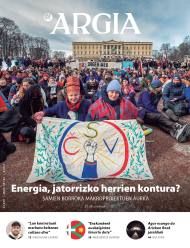Since the previous month an urban concept has entered public debate: a city of 15 minutes. Some suspect that behind the idyllic city that promotes closeness and well-being there is a closure structure that seeks to confine our lives in areas of ghettos and isolated bubbles to control society. Among the claims that have not been made is the ban on the use of private cars. The measures adopted at the end of 2020 were a preliminary test of a 15-minute city and now the model is spreading among European cities as the main urban design policy.
The urbanist Carlos Moreno has proposed to transform the parameter of time to urban and territorial ordination through chrono-urbanism, defining times from 15 to 30 minutes. Moreno is credited with the invention of the model and has denounced that, along with the publication of the book on urbanism of proximity, he has suffered persecution on social networks as ideologues of a plan that hides ungiven objectives.
Suppose that yes, among the goals of the 2030 Agenda is the establishment of a 15-minute city model and with social engineering in progress. Does this matter if our life is to get a day without a car? I have perceived contradictory fears of loss of freedom and totalitarianism, without referring to the way of life promoted by the model.
In the speeches of the leftist policies, a 15-minute city model has been acquired at the gates of the elections, and often the difficulties and consequences of the model do not get deeper. But the final goal of the 15 minutes, with broad theoretical bases, is to encourage love for the place where we live, as love is practiced in daily walk and close by. Maybe we should take the controversial city model to the debate about love.
Bidali zure iritzi artikuluak iritzia@argia.eus helbide elektronikora
ARGIAk ez du zertan bat etorri artikuluen edukiarekin. Idatzien gehienezko luzera 4.500 karakterekoa da (espazioak barne). Idazkera aldetik gutxieneko zuzentasun bat beharrezkoa da: batetik, ARGIAk ezin du hartu zuzenketa sakona egiteko lanik; bestetik, egitekotan edukia nahi gabe aldatzeko arriskua dago. ARGIAk azaleko zuzenketak edo moldaketak egingo dizkie artikuluei, behar izanez gero.
Azkar! Azkar! Adi egon, ez daukat astirik eta! Ohartarazi behar zaitut, denborak agian ez baitit uzt… Pipipipi-pipipipi! Pipipipi-pipipipi!
Goiz jaiki, eguneratuta egoteko irratia piztu, dutxa hartu, ilea lehortu, orraztu, bizarra kendu edota makillatu, kafea egiten den... [+]
Ez da berria, lehen ere ezagutu ditugu horrelako egoerak. Bere garaian hartutako erabakiaren emaitzak okertzen doazenean, zuzentzeko nahiko denbora balego bezala, eta ez da egia.
Hitz politak, itxaropentsuak, euskal gizartean pozik entzuten direnak, bai, baina badut beldurra,... [+]
Azpeitiko Udalak etxebizitza hutsei ezarritako kanona abian jarri berritan –eta Euskadi osora zabal daitekeela jakinda–, etxebizitza horien jabeen eta eskuineko alderdien kexak irakurtzen eta entzuten hasiko gara. Jabetzarako Eskubidearen inguruko mantra horiek... [+]
Lurrak guri zuhaitzak eman, eta guk lurrari egurra. Egungo bizimoldea bideraezina dela ikusita, Suitzako Alderdi Berdearen gazte adarrak galdeketara deitu ditu herritarrak, “garapen” ekonomikoa planetaren mugen gainetik jarri ala ez erabakitzeko. Izan ere, mundu... [+]
Martxoaren 13an lau urte bete dira Fran Balda arbizuarra istripuz hil zela. Preso, iheslari eta deportatuen etxeratzearen alde egin zuen lan, eta haren bost kidek idatzi diote gutun hau.
Zinez txalogarria, eskolako irakasle talde jakin baten borondatez, eta zenbait gurasoren inplikazioz, A ereduko ikastetxe estigmatizatu bat D ereduko eskola bilakatzeko abian jarri duten prozesua Gasteizko Judimendi auzoan. Honela, posible egiten ari dira Araba, Bizkaia eta... [+]
2025-2026 ikasturterako matrikulazio kanpaina hasi baino bi aste lehenago, Hezkuntza Saileko arduradunengana jo genuen, itunpeko eskoletako gelen ituntze maila ez delako egokitzen demografiaren jaitsierara eta indarrean dagoen lege esparrura.
Hiri gehienetan arazo orokorra... [+]
1986. urtean Espainiako Estatuak NATOn jarraitzearen aurkako botoa eman zuen euskal gizarteak. Denborak ematen duen perspektibak oraindik ez du azaldu zeintzuk izan ziren gizartearen arrazoi sakonak gerra erakundean parte hartzeari uko egiteko.
Felipe Gonzálezen... [+]
Martxoaren lehenengo lanegunarekin batera, komunikabideetan azalduko ez diren aldaketak etorri dira EHUn. Azken Lan Publikoko Eskaintzaren ondorioz, ehunka langile –arlo tekniko eta administrazio zerbitzutakoak– orain arte okupatzen zuten lanpostutik atera eta beste... [+]
Bolo-bolo dabil energia berriztagarrien hedapenaren inguruko eztabaida. Sarri askotan, iritsi den proiektu zaparrada desordenatuak eragindako artegatasunak bultzatuta, albiste zein iritzi-artikulu mordoaz gain, hitzaldiak, eztabaidak, mahai inguruak, bideo emanaldiak eta abar... [+]
Lagun asko sumatu dut kezkatuta euskaldun gero eta gutxiagok ahoskatzen duelako elle-a. Haur eta gazte gehienek bezala, heldu askok ere galdu du hots hori ahoskatzeko gaitasuna, idatzian ere nahasteraino. Paretan itsatsitako kartel batean irakurri berri dugu: altxorraren biya... [+]
Unibertsitateko ikasleen artean, maiz topatzen ditugu beste lurraldetakoak ere, bereziki gradu ondorengo ikasketetan. Topaketa horiek badira errealitate berriak ezagutzeko bide, baita besteak entzun eta besteez ikasteko parada ere. Garapenerako lankidetzari loturiko gaiak izan... [+]
Sare sozialetan badira zenbait pertsona eragin gaitasun handikoak. Jarraitzaile ugari dute, eta euren iritziak egiatzat hartzen dira. Askok, ordea, egia barik, interes propioa edo klase baten interesak iraunkortzea bilatzen dute. Ameriketan komentokrata deitzen zaie. Alegia,... [+]
Antifaxismoari buruz idatzi nahiko nuke, hori baita aurten mugimendu feministaren gaia. Alabaina, eskratxea egin diote Martxoaren 8ko bezperan euskal kazetari antifaxista eta profeminista bati.
Gizonak bere lehenengo liburua aurkeztu du Madrilen bi kazetari ospetsuk... [+]


















